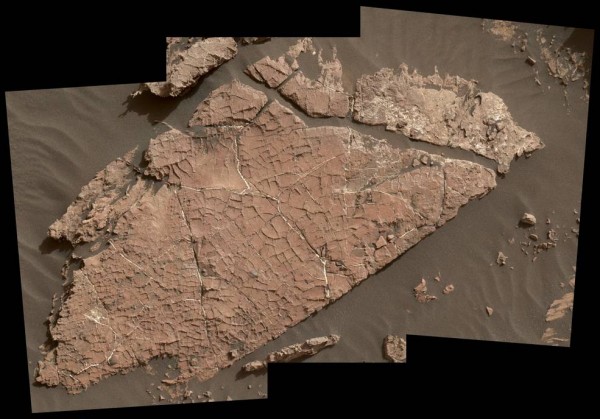By Ana Verayo, | January 20, 2017

The network of cracks in this Martian rock slab called "Old Soaker" may have formed from the drying of a mud layer more than 3 billion years ago. (NASA/JPL-Caltech/MSSS)
NASA's Mars Curiosity rover has discovered some interesting "ancient mud cracks" on the surface of the Red Planet, indicating the evidence of water and hinting that this dry planet could have once been a wet world.
Like Us on Facebook
The Martian rover captured these photos on December 20 from a site known as the "Old Soaker" which is located in the lower regions of Mount Sharp. The images were released by NASA on January 17. Mission scientists suggest that this cracked layer was first formed some three billion years ago due to numerous wet and dry cycles.
NASA's Curiosity rover found crucial evidence of water on Mars in 2015, when it detected some lower rock layers of an ancient lake and in younger mud stone layers around the Old Soaker. However, the newest photos of Mars can be considered as first evidence of mud cracks or "dessication cracks" that are confirmed by mission scientists.
According to Nathan Stein of the California Institute of Technology, these are most likely mud cracks, and even from a distance, there are patterns revealing four and five sided polygons.
NASA scientists have explained this phenomenon at the Old Soaker, stating that this cracked layer was buried by sediment over time and creating stratified rock. This layer was then exposed by wind erosion with raised ridges of sand and dust that filled these cracks. Scientists added that there are underground fractures due to pressure from overlaying sediment at the Old Soaker.
According to Ashwin Vasavada of NASA's Jet Propulsion Laboratory, if these are mud cracks, then they can be considered as evidence of ancient lakes varying in depths. These lakes may have gone through dry periods through time.
NASA scientists say that further observations of Mount Sharp can help them determine how Mars turned into a dry planet.
-
Use of Coronavirus Pandemic Drones Raises Privacy Concerns: Drones Spread Fear, Local Officials Say

-
Coronavirus Hampers The Delivery Of Lockheed Martin F-35 Stealth Fighters For 2020

-
Instagram Speeds Up Plans to Add Account Memorialization Feature Due to COVID-19 Deaths

-
NASA: Perseverance Plans to Bring 'Mars Rock' to Earth in 2031

-
600 Dead And 3,000 In The Hospital as Iranians Believed Drinking High-Concentrations of Alcohol Can Cure The Coronavirus

-
600 Dead And 3,000 In The Hospital as Iranians Believed Drinking High-Concentrations of Alcohol Can Cure The Coronavirus

-
COVID-19: Doctors, Nurses Use Virtual Reality to Learn New Skills in Treating Coronavirus Patients







